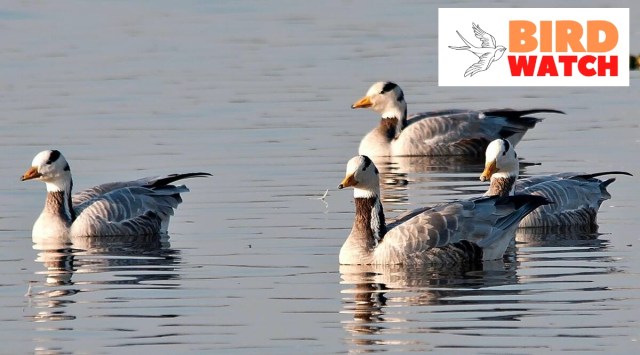- India
- International
Birdwatch: Meet bar-headed goose, the high-flyer that lands at Sukhna
Bar-headed geese migrate in flocks and nest in colonies of thousands. In the tricity, they can be seen in the Sukhna Lake, Mote Majra, Siswan and other water bodies.

Written by Mitinderpal Singh Sekhon
The bar-headed goose (Anser indicus) is a pale grey bird, easily distinguished from any of the other grey geese of the genus Anser by black bars on its head, yellow-orange beak and same coloured legs. A mid-sized goose, it measures 71–76 cm (28–30 in) in total length and weighs 1.87–3.2 kg (4.1–7.1 lb).
They are social birds that breed in Central Asia and winters in South Asia, migrating south from Tibet, Kazakhstan, Mongolia, and Russia before crossing the Himalayas. In the tricity, they can be seen in the Sukhna Lake, Mote Majra, Siswan and other water bodies.
They migrate in flocks and nest in colonies of thousands. They fly in V-shaped formations to maintain spacing while flying and to communicate with each other visually and vocally.
Bar-headed geese are very powerful fliers capable of flying through the passes of the high mountains at heights of 3,658 to 4,267 m (12,000 to 14,000 ft), winds that blow at speeds of more than 322 kph (200 mph) and temperatures low enough to freeze exposed flesh instantly.

Their powerful and constant flight helps generate body heat, which is retained by their feathers. Such heat helps keep ice from building up on their wings when flying over mountains. These geese also have a special type of haemoglobin that absorbs oxygen quicker than other birds; they extract more oxygen from each breath than other birds can. They can migrate more than 1,609 km (1,000 miles) in a single day.
Scientists believe the geese’s yearly migration is triggered by an environmental signal that allows them to miss the summer monsoon season and the worst winter storms.
Bar-headed geese are herbivores and feed mainly on grasses that surround lakes where they nest. They also eat corn, barley, rice, wheat, and occasionally take mollusks, insects, and crustaceans.
According to the International Union for Conservation of Nature (IUCN), the conservation status of bar-headed goose is ‘least concern’. Main threats to bar-headed geese include habitat loss, overhunting, egg collection and persecution from farmers as large flocks may damage grain crops.
Apr 25: Latest News
- 01
- 02
- 03
- 04
- 05








































